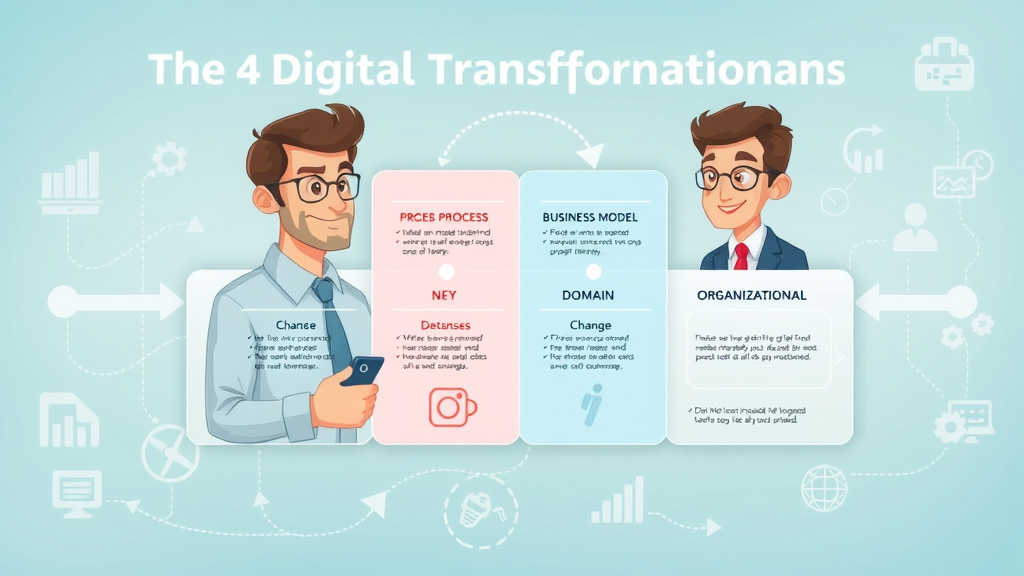Did you know that over 70% of small businesses embracing digital transformation report significant revenue growth within the first year ? In today’s rapidly changing digital landscape, becoming a forward-thinking business pro isn’t a luxury—it’s a necessity. From operational improvements to next-level customer experiences, digital transformation for small businesses is the game-changer small business owners cannot afford to miss. Whether you’re an established small business owner or just stepping into entrepreneurship, this guide unveils practical, results-driven steps to propel your business into a successful digital future.

Why Digital Transformation for Small Businesses Is Essential in 2024
The year 2024 marks a turning point in how small businesses compete, grow, and stay relevant. Digital transformation for small businesses is no longer just about using the latest digital technologies or social media tactics—it’s about rethinking your entire business model. As consumers increasingly expect seamless digital experiences and fast, personalized services, small business owners must adapt or risk losing market share to competitors investing in emerging digital systems.
Imagine being able to access data analytics in real-time, automate repetitive business processes, or offer AI-enhanced customer service that wows clients around the clock. This is the reality for business owners who’ve embraced digital transformation. As highlighted in recent studies, small businesses taking the leap are reporting not only increased revenue but also improved efficiency, better customer experiences, and heightened employee satisfaction. That’s why digital transformation for small businesses is absolutely essential—the gap between digital leaders and laggards is widening, and those who act now will secure their place as business pros of the future.
"Over 70% of small businesses embracing digital transformation for small businesses have reported significant revenue growth within the first year."
Key Benefits of Digital Transformation for Small Businesses
Embarking on digital transformation unlocks a wide range of advantages for small business owners. By integrating digital tech and automating business processes, you open doors to faster operations, lower costs, and a more agile business model. One of the most significant benefits is how data analytics can inform better decision making, driving sales, and cutting waste across your organization.
Enhanced customer experience is at the forefront of every competitive business. Personalization, convenience, and multi-channel engagement are expected by today’s consumers. With digital transformation, small and medium business owners are equipped to build loyalty and streamline services, responding faster to client needs. As a result, retention rates rise, and so does your reputation.
- Increased operational efficiency through digital technologies
- Enhanced customer experience and retention
- New business model opportunities for small businesses
- Real-time analytics and data-driven decision making
- Improved scalability for small business owners
What You'll Gain by Adopting Digital Transformation for Small Businesses
When you make the leap into digital transformation for small businesses , you don’t just add new systems—you gain a clear, actionable strategy that positions your business for sustainable growth. From understanding which digital tools deliver real ROI to implementing effective change in workflows, your knowledge will go beyond surface-level digital tech trends.
You’ll see first-hand examples of small business digital strategies that work, insights into assessing your team’s readiness, and a step-by-step approach to launching transformation for small business operations. With the included readiness checklist and practical stories, you’ll be empowered to move from planning to doing, ensuring your business pro journey is fueled by confidence and clarity.
- Clarity on modern digital transformation strategies
- Real-world examples relevant to small business owners
- Step-by-step guidance to launching your own business digital transformation
- Checklist to assess your digital transformation readiness
Understanding Digital Transformation for Small Businesses
What is the Digital Transformation of Small Businesses?
At its core, digital transformation for small businesses means using digital technologies to fundamentally improve how your business operates, serves customers, and competes in the market. It’s not simply about adopting new digital tools; it requires a mindset shift to rethink business processes, deliver new customer experiences, and regularly update strategies to keep pace with digital trends.
For many small business owners , digital transformation is the process that enables them to expand into new markets, streamline operations, and leverage cloud computing to access information from anywhere. By transforming legacy business systems—including everything from accounting to customer service—small and medium businesses can run leaner, faster, and smarter. The transformation for small business success rests on integrating technology with a strong business model and a culture that welcomes change.
The 4 Types of Digital Transformation for Small Business
Every journey toward business digital transformation includes one or more of four distinct types: process transformation (changing how you do work), business model transformation (rethinking how you generate revenue), domain transformation (entering new markets or adopting new technologies), and organizational/cultural transformation (aligning your team and culture with your digital goals). Each type serves a unique role in helping small businesses transition from traditional operations to modern, tech-driven approaches.
By understanding these four transformation types, small business owners and teams can prioritize their efforts and allocate resources where they’ll have the most impact. For example, a bakery might focus first on automating scheduling (process), while a local retailer could revamp their online store to tap into e-commerce (business model). Embracing these types in a strategic sequence leads to sustainable, holistic change.
- Process Transformation
- Business Model Transformation
- Domain Transformation
- Organizational/Cultural Transformation

Decoding the 4 P’s of Digital Transformation for Small Businesses
The “4 P’s” offer a powerful framework for digital transformation for small businesses, outlining the core pillars: People, Processes, Platforms, and Performance. By focusing on each area, you ensure your transformation strategy balances technology upgrades with the human and operational elements required for lasting success.
For example, “People” refers to ongoing training and developing a team that embraces new technologies. “Processes” involves rethinking and redesigning workflows with efficiency in mind. “Platforms” focus on selecting the right digital systems (like cloud computing and CRM tools) that enable your business to scale easily. Lastly, “Performance” is all about tracking results and adjusting strategies based on real data.
| Pillar | Description |
|---|---|
| People | Upskilling teams to embrace new digital tech |
| Processes | Optimizing workflows using digital technologies |
| Platforms | Adopting cloud and IT solutions for scalability and flexibility |
| Performance | Measuring and enhancing results continuously |
The 5 Main Areas of Digital Transformation for Small Businesses
To ensure complete business digital transformation, focus on these five key areas: Customer Experience , Operational Agility , Culture and Leadership , Workforce Enablement , and Digital Technology Integration . Each area represents a crucial aspect of your business, all of which must evolve for you to fully benefit from digital transformation solutions.
For example, improving customer experience might involve using social media and digital systems to answer queries instantly, while operational agility may come from streamlining your business processes with cloud computing and data analytics. Empowering your workforce with modern digital tools and fostering a culture of innovation ensures that changes are enduring and drive tangible business growth.
- Customer Experience
- Operational Agility
- Culture and Leadership
- Workforce Enablement
- Digital Technology Integration

Building a Digital Transformation Strategy for Small Business Success
Assessing Your Small Business Digital Transformation Readiness
Before rushing into new digital tech, assess your small business digital transformation readiness . Begin by conducting a digital capabilities audit to identify the current strengths and limitations of your processes and technologies. Look for inefficient workflows, outdated IT infrastructure, or gaps in customer experience that could benefit from transformation.
It’s crucial to evaluate not just the technology, but also the readiness of your small business owner and team. Consider whether you have the skills, digital systems, and open culture needed to adopt emerging technologies. Only by taking stock of where you are today can you chart an effective path toward a thriving, future-ready business.
- Conduct a digital capabilities audit
- Identify gaps in existing digital technologies
- Evaluate readiness of small business owners and teams
Setting Digital Transformation Goals & KPIs for Small Businesses
Success in digital transformation for small businesses begins with clear, measurable goals. Consider what you want to achieve: Is it increasing online sales, improving customer retention, or achieving more efficient business processes? Choose relevant Key Performance Indicators (KPIs) that will allow you to track progress, such as time saved, cost reductions, or customer satisfaction scores.
Using digital tools like cloud-based dashboards and AI-driven analytics, you can visualize results in real time and make data-backed adjustments on the fly. Align these metrics with your strategic business model so every team member understands how their efforts drive digital transformation forward. Regularly reviewing and refining these KPIs ensures you stay agile and on target.

Case Studies: Small Businesses Winning Big with Digital Transformation
Nothing demonstrates the value of digital transformation better than real-world success stories. Across industries, small businesses are using digital technologies to outperform competitors and delight customers. For example, Toolbox Pros slashed operational costs by digitizing workflows, while Crafty Cakes leveraged online ordering and customer feedback to boost sales by 35%. These businesses found transformative outcomes by merging strategic business processes with targeted tech upgrades.
"Our shift to digital platforms doubled our customer base in six months." — Anna, small business owner
| Business Name | Transformation Focus | Outcome |
|---|---|---|
| Crafty Cakes | Customer experience (digital ordering) | +35% sales |
| Toolbox Pros | Operational digitization | Reduced costs by 20% |
| GreenPrint Studio | Digital marketing | +300 new clients via social |
Choosing the Right Digital Technologies for Small Businesses
Must-Have Digital Tech for Modern Small Businesses
To succeed, today’s small businesses need to select digital technologies tailored to their goals. Cloud-based accounting platforms simplify financial management while providing anytime, anywhere access to business data. CRM (Customer Relationship Management) tools allow for tracking leads, organizing contacts, and creating repeatable, high-quality customer experiences .
Digital marketing platforms empower business owners to reach target audiences via social media, while AI-powered analytics tools turn data into actionable insights for better business decision making. Incorporating such modern digital tech creates a robust, scalable foundation, ensuring your small business can adapt to changing demands and grow effortlessly.
- Cloud-based accounting software
- CRM tools for customer experience improvements
- Digital marketing platforms for small business owners
- AI-powered analytics for data insights
| Technology | Use Case | Small Business Benefit |
|---|---|---|
| Cloud Computing | Access files remotely | Increased productivity |
| CRM Systems | Manage customer relationships | Higher retention |
| Project Management Apps | Track tasks & deadlines | Better team coordination |
Steps to Launch Digital Transformation for Small Businesses
Embarking on business digital transformation requires a structured approach. Begin by building a dedicated transformation team, even if it’s just a few key employees or outside consultants. Next, map your current processes to spot where digital improvements can offer the most impact—think about tasks that consume time or frustrate employees and customers alike.
Once pain points are clear, choose digital technologies that best support your small business model and goals. Always keep customer experience at the core of your transformation, making changes incrementally and analyzing results closely. This phased approach ensures transformations are manageable, measurable, and fully support sustainable business growth.
- Create a dedicated digital transformation team or task force
- Map current processes and identify digital gaps
- Select technologies aligned with your small business goals
- Prioritize customer experiences throughout the transformation
- Implement changes incrementally and measure results

Overcoming Common Digital Transformation Challenges for Small Business Owners
Budget Constraints in Business Digital Transformation
Many small businesses worry that digital transformation is too expensive. The truth is, you don’t need massive budgets to start. Affordable cloud computing and subscription-based digital tools let small business owners upgrade systems without hefty up-front costs. Prioritize investments by focusing on technologies that will most directly impact your business processes and customer experiences.
Explore grants, local initiatives, and technology partners that support small and medium enterprises in their digital journeys. Many digital solutions are scalable, allowing you to add features as your business grows. Focus on incremental improvements, like cloud-based accounting or social media automation, to maximize value without overwhelming your budget.
Digital Skill Gaps in Transformation for Small Businesses
A successful transformation for small business depends heavily on your team’s ability to embrace and utilize new technologies. Often, small businesses face digital skill gaps—employees may be unfamiliar with analytics dashboards, automation tools, or customer relationship platforms. Proactively offering training ensures no one gets left behind.
Supplement training by hiring digital consultants for specialized tasks and taking advantage of free or low-cost online learning platforms. Creating a learning culture within your business doesn’t just speed up transformation, it empowers your whole team to contribute new ideas and technology solutions for ongoing improvement.
- Offer digital skills training for small business teams
- Hire digital consultants temporarily
- Engage in online learning platforms focused on digital transformation
Managing Resistance to Change with Small Business Employees
Change can be intimidating, especially for small business teams used to traditional processes. Resistance is a natural reaction, but it doesn’t have to be a roadblock. Clear communication, transparent goal-setting, and involving employees in key decisions foster buy-in and create a positive environment for transformation.
Recognize employee concerns and highlight the specific benefits digital transformation will bring, such as less repetitive work or a more flexible schedule. Motivation and support from business owners make adaptation smoother and more successful—a win-win for the team and customers alike. Ultimately, a culture of open dialog and recognition accelerates the shift to a digital-first business.

Maximizing Customer Experience with Digital Transformation for Small Businesses
Personalization and Seamless Interactions in Small Business Digital Transformation
One of the most powerful advantages of digital transformation for small businesses is the ability to deliver personalized, frictionless experiences at every touchpoint. Leveraging artificial intelligence, automation, and robust CRM systems, small business owners can anticipate needs, resolve issues quickly, and create memorable journeys for every customer.
Your website, social media, and even in-store experiences can be integrated into a unified digital system. Constantly collecting and applying customer feedback allows for continuous improvement. The result is increased loyalty, higher customer lifetime value, and an expanded client base—all driven by smart, adaptable digital strategies.
- Leverage AI to automate support and personalization
- Enhance your website and online presence
- Collect and act on customer feedback continuously
Future Trends in Digital Transformation for Small Businesses
As digital transformation evolves, several trends stand out for small business leaders. Artificial intelligence and automation are becoming standard, from chatbots for customer service to automated data analytics informing business strategy. Hybrid workplaces—where teams collaborate both in-person and online—are also on the rise, offering flexibility and broadening talent pools.
The integration of digital customer experiences—like online shopping paired with in-store pickup—is rapidly expanding. Digital payments and e-commerce options continue to grow, meeting consumers’ demand for convenience and security. Staying ahead means continually monitoring innovations and being ready to pivot your business model for maximum relevance and resilience.
- Increased use of AI and automation in small business operations
- Growth of hybrid workplaces for small businesses
- Greater integration of digital customer experiences
- Expansion of digital payment and e-commerce options
Watch the inspiring journey of a local coffee shop that transformed their business through digital tools—growing online orders, building brand loyalty via social media, and optimizing operations using cloud solutions. This real-life example demonstrates how small businesses can thrive in a digital world.
Step-by-Step Video Tutorial: Getting Started With Digital Transformation for Small Businesses
Follow along with our comprehensive video walkthrough, where we guide you through assessing readiness, setting goals, selecting the right technology, and measuring your digital transformation success. Designed for small business owners, this tutorial turns insight into action for your business digital journey.
People Also Ask: What is the Digital Transformation of Small Businesses?
The digital transformation of small businesses is the process of adopting digital technologies to enhance how a business operates, delivers value, and connects with customers. It involves updating business systems, streamlining operations, and introducing innovative products and services that ensure a competitive advantage in a digital-first economy.
This process can include everything from moving accounting systems to the cloud to using social media for marketing and adopting artificial intelligence for data analytics. Digital transformation equips small and medium businesses with the agility and scalability needed for sustained growth.
People Also Ask: What are the 4 Types of Digital Transformation?
The four types of digital transformation are: Process Transformation (improving internal workflows), Business Model Transformation (changing how you generate revenue), Domain Transformation (shifting to new markets or industries), and Organizational/Cultural Transformation (cultivating a team that embraces innovation). Addressing one or more of these types helps small business owners keep their operations modern and competitive.
Each type responds to different strategic goals—from increasing efficiency to seizing new market opportunities or improving internal collaboration and digital skill sets within your workforce.
People Also Ask: What are the 4 P's of Digital Transformation?
The 4 P’s of digital transformation stand for People (team capabilities), Processes (efficient workflows), Platforms (reliable technology and systems), and Performance (continuous measurement and improvement). These pillars ensure a balanced strategy—combining tech adoption with strong organizational foundations.
Success depends on giving equal attention to training staff, optimizing business processes, choosing the right digital systems, and tracking outcomes to adjust strategies as needed.
People Also Ask: What are the 5 Main Areas of Digital Transformation?
The five main areas are: Customer Experience , Operational Agility , Culture and Leadership , Workforce Enablement , and Digital Technology Integration . Small businesses thrive when they approach digital transformation holistically, improving both their external interactions and internal operations.
Focusing on these areas ensures transformation touches every critical part of your business, resulting in sustainable advantages and ongoing growth.
Frequently Asked Questions About Digital Transformation for Small Businesses
-
How can small businesses start with digital transformation?
Begin by assessing your current digital capabilities and identifying key goals. Map out areas with the most inefficiency or potential for impact, and prioritize investments in digital technologies that align with those business needs. Incremental adoption supported by proper training is the best approach for success. -
Is digital transformation only for technology companies?
No—digital transformation benefits all small and medium businesses, regardless of industry. It’s about optimizing business processes, enhancing customer experiences, and unlocking new growth opportunities by leveraging digital technologies—even in traditional sectors. -
What’s the average cost for digital transformation for a small business?
Costs vary widely based on project size and tech choices. Many digital solutions offer subscription-based or pay-as-you-go models, allowing small business owners to begin with a modest budget. Grants and local support programs can further offset initial investments. -
How to measure digital transformation success?
Track improvements using KPIs like increased sales, reduced operation times, improved customer satisfaction, and higher retention rates. Regular analysis of data ensures you stay on course and can adjust strategies for optimal outcomes.
Summary: How to Begin Your Digital Transformation for Small Businesses Today
- Embrace digital transformation as ongoing progress
- Focus on customer experience and business model agility
- Invest in upskilling and the right digital technologies
Ready to Transform? Take the First Step Toward Digital Transformation for Small Businesses
Explore your readiness, set bold goals, and get your team on board— your digital transformation journey starts now . Unlock new growth by empowering your small business with future-ready digital strategies.
Sources
- Harvard Business Review
- McKinsey & Company
- Salesforce Small Business Digital Transformation
- Deloitte Digital Transformation Survey
To further enhance your understanding of digital transformation for small businesses, consider exploring the following resources:
-
“Digital Transformation Strategies for Small and Mid-Size Businesses” : This article outlines practical steps for small and mid-size businesses to embark on their digital transformation journey, including developing a strategic roadmap and establishing clear metrics to measure success. ( americanexpress.com )
-
“Digital Transformation Strategies For Small And Medium Enterprises” : This piece discusses various strategies such as exploring cloud computing, utilizing data analytics, and fostering an innovative culture to drive digital transformation in small and medium enterprises. ( forbes.com )
These resources provide actionable insights and strategies to help small businesses navigate and implement digital transformation effectively.
 Add Row
Add Row  Add
Add 




Write A Comment